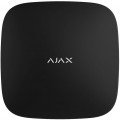Wireless zones
The number of security zones that can be covered by this kit when using wireless sensors.
In this case, a security zone means a separate protected area for which you can separately set the operating mode — for example, "Protection", "Protection disarmed" or a special tracking format. On many models, the number of zones corresponds to the maximum number of wireless sensors that can be connected to the device (see "Wireless Sensors"). However, there are exceptions: for example, a model for several dozen sensors can have 6-10 protection zones, in the expectation that one zone will be served simultaneously by several sensors.
Security functions
—
Partial security. Possibility of work of a set in the mode of partial protection. In this mode, the alarm does not arm the entire protected space, but only a part of it — for example, individual rooms, or only sensors of a certain type (opening, movement). Specific features of the partial protection format may be different, they should be specified separately in each model. However, anyway, this function expands the capabilities of the signaling and may be useful in some specific situations. For example, in a residential building at night, you can turn on the perimeter sensors without using motion sensors — in this way, the alarm will only turn on when you try to enter the house and will not respond to people inside.
—
Alarm on pressing the button. Possibility to turn on the alarm signal manually by pressing a special button. This function will be indispensable in extreme situations in which automatic sensors are useless — for example, during an open robbery or attack. Specific alarm functions, of course, may be different: some models include a siren, others are able to send a signal to the dispatcher's console, etc.; these details should be specified separately.
—
Auto arming. Possibility of automatic arming of the alarm system. Most often, in this case, the inclusion of protection is implied by the schedule of hours and days of the week specified b
...y the user; some models allow you to store several schedules in memory at once. This feature ensures that the protected zone "out of hours" will not be left without an alarm, even if the user forgets to turn it on manually. In addition, other methods of auto-arming may be provided — for example, when all key fobs are removed from the communication zone; the presence of such functions should be clarified separately.Max. wireless sensors
The number of wireless sensors that can be simultaneously connected to the central unit (if this connection format is supported — see "Connecting sensors"). This number, by definition, is not less than the number of wireless zones (see the relevant paragraph).
Note that even the most modest modern systems support 6 – 8 wireless sensors, in the most advanced models this number can exceed 100. So you have to pay attention to this parameter mainly in cases where you need to organize a very extensive alarm system.
Key fobs communication range
The distance at which the connection of the control key fobs with the central alarm unit is maintained. This is a rather approximate, moreover, a very conditional indicator: the characteristics usually indicate the distance in perfect conditions — with line of sight, without interference and obstacles between the key fob and the control panel. In fact, the communication range may be less than stated, especially if the key fob has to work through walls. So it is worth choosing according to this indicator with a certain margin.
Also note that this parameter is indicated in the specifications for regular key fobs — complete or recommended by the manufacturer; when using "non-native" accessories, the communication range may be reduced.
Users (numbers to call)
The number of users or voice call numbers that can be stored in the device's memory.
The very possibility of a call, of course, is found only in models with support for remote control — via GSM or Wi-Fi (see "Control"). Systems with this function, when triggered, send a voice call to specified users via the mobile network to a phone or via the Internet to an application on a smartphone / tablet. Having accepted the call, the user receives voice information about the details of the alarm, and also, in most cases, gets access to additional functions: control via the voice menu, intercom, listening (see "Control panel capabilities"), etc. Many modern alarm systems allow set not one recipient of such calls, but a whole list: if there is no connection with one user, the system will try to call the second, if he does not answer, the third, etc. This will be useful in cases where several people are responsible for signaling.
Max. humidity
The highest relative humidity at which the alarm is able to operate normally.
Excessive humidity leads to water settling on the system components, which can affect their performance and even lead to breakage. Therefore, modern electronics, including alarms, usually have limits on permissible humidity. However, you need to pay attention to this indicator mainly in cases where the kit is planned to be used outdoors or in rooms with initially high humidity, such as swimming pools or water parks — for such cases, it is desirable that the humidity limit be at least 90%. But in residential and office premises, humidity rarely exceeds 80%, and such conditions can endure almost all modern alarm systems.

